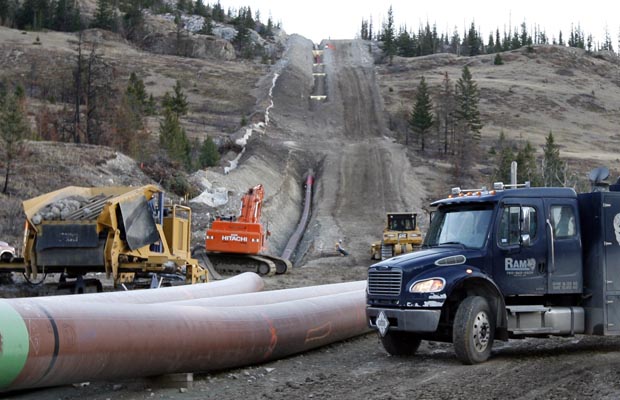EDMONTON – Most Albertans do not believe the so-called “bitumen bubble” is the prime source of the province’s financial woes, according to a new poll.

Since Premier Alison Redford introduced the “bitumen bubble” to mainstream conversations during a televised speech in January, the government has warned the discounted price for Alberta crude will inflict a $6-billion hit on the provincial treasury this year.
But an online survey by Leger Marketing found that only one-fifth of Alberta voters believe the combination of pipeline constraints and oil price differentials is “primarily responsible” for the government’s financial problems.
A majority, 65 per cent, said the bubble was not the prime culprit behind the budget crunch. The remaining 16 per cent said they “don’t know.”
Leger’s Alberta vice-president, Ian Large, said he was surprised to see that nearly two-thirds of respondents reject the “bitumen bubble” explanation as the main reason for Alberta’s financial woes.
Calgary voters were slightly more likely than Edmontonians and residents in other parts of the province to say the bitumen bubble was the main source of money problems.
Large said he believes several factors are influencing public opinion on the issue.
For one, it is complicated to explain the causes behind Alberta’s fluctuating oil prices compared to the North American benchmark. At its low point in January, Alberta crude was selling for about $37 less per barrel than West Texas Intermediate, but that gap shrank to about $14 per barrel in March.
Meanwhile, other questions previously released from the Leger poll, commissioned by the Journal and the Calgary Herald, found that the Tories face a sharp slide in support as they are dogged by an array of trust and accountability issues.
Though the government is correct to point to problems with resource revenue caused by pipeline capacity and fluctuating oil prices, “because of all the frustrations with all the other issues, people aren’t buying it,” Large said.

Get breaking National news
The controversial 2013-14 budget delivered March 7 also distracted from the overall revenue challenges, Large said. The budget included a freeze to overall operational expenses, cuts in some areas and a sixth consecutive deficit. It also laid out a plan to borrow billions of dollars for infrastructure, in addition to a plan to start saving money again in 2014-15.
“I think that this message was lost both in the budget and then in the push back from the opposition,” Large said. “The opposition’s comment was: ‘This isn’t news. We’ve always had this problem. Why is this all of a sudden news?’
“So the government was not able to really make this argument very clearly.”
Faron Ellis, a political scientist at Lethbridge College, said the Redford government deserves credit for educating Albertans about the different price it gets for its oil.
If pollsters asked a different question, such as “Are you aware that pipeline capacity and what’s called the ‘bitumen bubble’ is an important long-term problem?” most Albertans would probably agree it is an issue.
“They’ve done a good job bringing the issue forward,” Ellis said. “Moving to the next stage and saying, ‘It is the cause of our current problems,’ there is considerable skepticism.”
Leger also asked 1,011 eligible voters in its non-random online survey if they had a favourable or unfavourable impression of the March 7 budget. Only 20 per cent reported a strongly or somewhat favourable impression, while 60 per cent said they somewhat or strongly disliked the spending plan.
Another 20 per cent said they could not offer an opinion.
Ellis, who studies and teaches polling methods as director of Lethbridge College’s Citizen Society Research Lab, said it should come as no surprise to anyone that six in 10 Albertans are unhappy with the budget.
“The Redford government was not given an austerity mandate. They campaigned on the progressive side,” Ellis said.
But Ellis said he was impressed Redford acknowledged Monday that she expected to take a political hit in opinion polls in the aftermath of the budget.
At this point, one year into a four-year mandate, her government is in a classic majority position, making tough calls early in the term, he said.
“We’ve seen many governments, federal and provincial, get through this,” Ellis said. “The test will be in three years. Has the situation been resolved? If it hasn’t, they will pay the price on the negative side. If it has, they’ll be rewarded.”
On the subject of cuts to post-secondary education, one of the most contentious pieces of the 2013-14 budget, more than 60 per cent of those polled said they disagreed with the decision to slash operating grants to colleges and universities by $147 million.
Edmonton residents were most unhappy about the cuts, with 67 per cent disagreeing compared to 60 per cent in Calgary and 57 per cent in the rest of Alberta.
“What’s surprising about this question is it wasn’t as universally condemned as I would have expected,” Large said. “There’s 26 per cent that agree with the decision.”
Although students, faculty and the mayors of Edmonton and Calgary have vocally opposed the advanced education cuts, Large said the government seems to have done a good job managing the fallout.
“I don’t think the government is going to hang on this one,” he said. “It really does affect a fairly small minority of the population.”
Leger conducted its online survey from April 9 to April 12. It does not a report a margin of error, but the company says a probability sample of this size would result in a maximum margin of error of 3.1 percentage points, 19 times out of 20.
That margin of error increases to more than five percentage points for regional breakdowns.






Comments